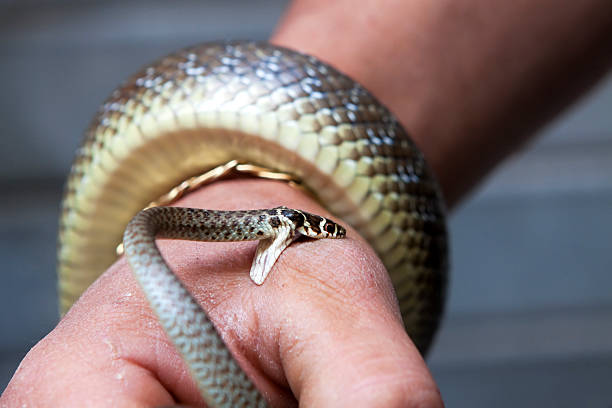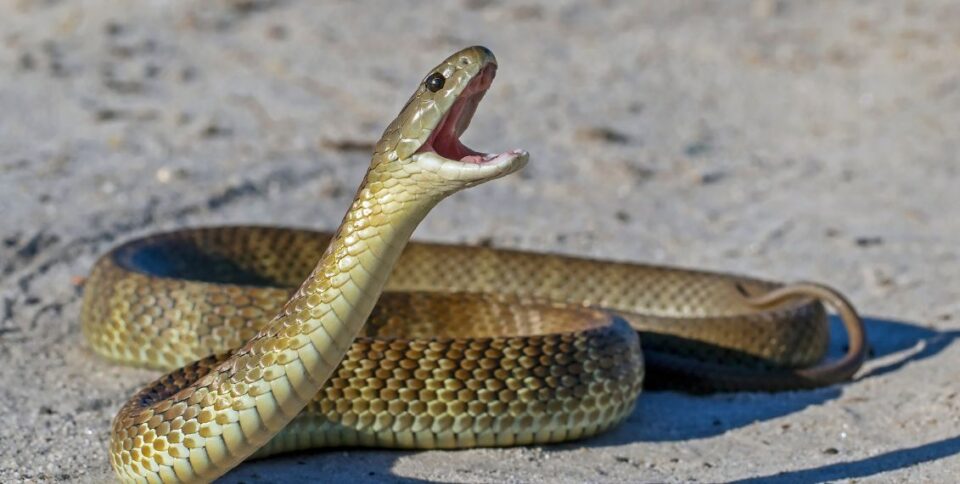NCRB(India), Snakebites: A farmer in rural Bihar heads into his field during a heavy monsoon downpour. His bare feet sink into the soaked earth as he checks his crops. Suddenly, a sharp sting hits his leg – a common krait, one of India’s deadly “Big Four” venomous snakes, strikes in the dark.
He limps home, heart pounding, but the nearest clinic is miles away, flooded roads make travel impossible. By dawn, his breathing falters, and the venom ends his life before help can arrive.
This is not a rare story. It’s a daily tragedy across South Asia, where snakebites silently claim tens of thousands of lives each year. The latest figures from India’s National Crime Records Bureau (NCRB) expose just how severe the crisis has become.
The Alarming Numbers
According to the NCRB’s 2023 report on Accidental Deaths and Suicides in India, 10,144 people died from snakebites – a slight 0.6% rise from 2022.
But these are just reported cases. The World Health Organization (WHO) estimates 58,000 annual deaths in India from 3-4 million bites, accounting for nearly half of all global fatalities.
Across South Asia, the picture is equally grim:
-
Pakistan: Over 40,000 bites a year leading to thousands of deaths.
-
Bangladesh: Around 20,000 deaths annually, many caused by kraits hiding in homes during monsoons.
-
Nepal: Venom-induced paralysis and bleeding claim lives in remote hilly villages.
Together, South Asian nations account for nearly 70% of global snakebite deaths. The culprits – the “Big Four”: Indian cobra, common krait, Russell’s viper, and saw-scaled viper are responsible for 90% of severe envenoming cases in India.
Half of all bites occur at night when people sleep on the floor, and 80% happen below 400 meters elevation, in dense, low-lying regions. Poor housing, barefoot farming, and rodent infestations draw snakes closer to human habitats making encounters inevitable.
Across South Asia, the region bears about 70% of global snakebite deaths, with countries like Pakistan, Bangladesh, and Nepal facing similar horrors due to shared geography and lifestyles. In Pakistan, over 40,000 bites occur yearly, leading to thousands of deaths, while Bangladesh reports around 20,000 fatalities, often from kraits hiding in homes during rains.
Nepal’s hilly farms see spikes too, with venom causing paralysis and bleeding in remote villages. These stats reveal a regional epidemic, fueled by venomous species like the Indian cobra, common krait, Russell’s viper, and saw-scaled viper – the infamous “Big Four” responsible for 90% of severe cases in India.
Yet, behind the numbers lie stories of loss: families shattered, farmlands abandoned, and children orphaned in the blink of an eye.
Why South Asia Bears the Brunt
South Asia’s vulnerability to snakebites stems from a perfect storm of human and environmental factors that make encounters inevitable. The region hosts over 300 snake species, many venomous, thriving in tropical climates with dense forests, rivers, and farmlands where billions live. India’s 1.4 billion people, with 65% in rural areas and 55% tied to agriculture, overlap constantly with these reptiles, especially during the June-to-September monsoon when floods drive snakes into homes and fields.

Half of all bites happen then, often at night when farmers sleep on the ground or work by dim light, and 80% occur below 400 meters elevation in low-lying, populous zones. Poor housing like mud huts with gaps for snakes to enter, exacerbates this, as do cultural practices like barefoot farming or storing grain that attracts rodents and their snake predators.
In other South Asian nations, similar patterns hold: Pakistan’s Indus Valley farms buzz with viper activity, Bangladesh’s delta regions flood yearly pushing cobras indoors, and Sri Lanka’s tea plantations hide kraits under leaves. Climate change worsens it, with warmer weather expanding snake habitats and intensifying monsoons.
Unlike Europe or North America, where bites are rare due to urbanization and fewer venomous species, South Asia’s agrarian poverty keeps people exposed. Men aged 30-69, the breadwinners, suffer most like more than 59% of cases but children under 15 make up a quarter of deaths, robbing futures before they begin. This isn’t just bad luck; it’s a systemic trap where poverty and nature collide.
The Invisible Crisis: Underreporting Snakebites
One of the cruelest aspects of this crisis is how underreported it remains.
NCRB data is based on police FIRs but countless deaths go unrecorded, especially in rural areas where families bury victims quietly without informing authorities.
The health ministry’s figures are far lower for 2022, it reported just one death nationwide versus NCRB’s 10,000 because many bites happen outside hospitals, treated by local healers or ignored until fatal. In rural India, cultural stigma around “unclean” deaths or fear of paperwork keeps incidents off records; in Andhra Pradesh alone, NCRB tallied 1,700 deaths from 2018-2022, but health data showed near zero for some years.
South Asia shares this plague: Pakistan underreports by 80% due to weak surveillance, Bangladesh’s flooded areas lose track of remote cases, and Nepal’s hills delay notifications. Traditional remedies like herbal poultices or incantation, delay hospital visits, and when deaths occur en route, they’re never logged. This undercounting isn’t accidental; it’s tied to overburdened systems where snakebites weren’t “notifiable” until recently.
As a result, policymakers lack data to act, and global estimates like WHO’s rely on studies showing India alone loses 1.2 million to bites over 20 years. Families suffer in silence, compensation schemes fail without proof, and the cycle of helplessness persists. Accurate reporting could save lives, but until every bite is tracked, the problem festers unseen.
Healthcare Gaps That Turn Treatable Bites Into Death Sentences
Even when victims reach healthcare facilities, systemic gaps often seal their fate.
The only effective treatment – antivenom (ASV) must be administered within hours. Yet, rural clinics often lack supplies or trained staff to administer it. Poor road connectivity and night-time bites delay care further.
-
66% of victims who receive treatment do so 1-6 hours after being bitten.
-
Delays cause paralysis, kidney failure, or respiratory collapse.
-
Primary Health Centres (PHCs) frequently refer patients to distant hospitals due to lack of expertise.
In many regions, polyvalent ASV fails to match regional venom profiles, reducing effectiveness. Survivors often face amputations or lifelong disabilities, deepening poverty.
Across South Asia, similar challenges persist:
-
Pakistan’s rural clinics lack serum stocks.
-
Bangladesh’s riverine islands have no medical facilities.
-
Nepal’s remote posts struggle with expired supplies.
This is not just a medical issue – it’s a failure of rural equity and public health planning.

The “Big Four” venoms vary regionally- vipers cause swelling in south India, kraits neurotoxicity in the east yet polyvalent ASV doesn’t always match, leading to repeat doses or failures. Add overburdened systems handling everything from malaria to floods, and snakebites become neglected.
Victims, mostly poor farmers and tribals, face amputation or lifelong disability if they survive, amplifying poverty. These gaps aren’t just logistical; they’re a failure to prioritize the vulnerable, leaving rural folk defenseless against a predictable foe.
Turning the Tide: Solutions Emerging from South Asia
Amid the crisis, hope is emerging through targeted interventions and local innovations.
India launched its National Action Plan for Prevention and Control of Snakebite Envenoming (NAPSE) in March 2024, aiming to halve deaths by 2030 in line with WHO goals.
Making snakebites notifiable since November 2024 ensures every case is reported, feeding data for smarter responses. Training programs like Snake Bite Life Support workshops have upskilled thousands of health workers in ASV use and first aid, reducing referral delays. Community education is key: simple steps like wearing rubber boots and gloves in fields, using torches at night, and clearing rodent-attracting clutter cut risks by 70% in trials.
Key steps include:
-
Making snakebites notifiable (since November 2024) to ensure every case is logged.
-
Training health workers through “Snake Bite Life Support” programs for rapid and safe ASV administration.
-
Community awareness campaigns teaching preventive practices like wearing boots, using flashlights, and clearing clutter reducing bite risks by up to 70%.
In Assam, awareness campaigns and CHC-level ASV halved deaths from 150 in 2022 to 36 in 2024.
Other South Asian countries are following suit:
-
Pakistan is expanding provincial ASV stockpiles.
-
Bangladesh trains frontline health workers for rapid response.
-
Nepal promotes first-aid education (“Don’t cut or suck”) through village drills.
Research fills gaps too: ICMR surveys across 14 states track burdens, while policy briefs push free ASV nationwide. International aid, like WHO’s global push, funds these, but success hinges on decentralising, tailoring to Bihar’s floods or Gujarat’s deserts. With sustained funding, equity focus, and cross-border collaboration, South Asia can tame this beast, turning anecdotes of loss into tales of resilience.
So, the farmer’s story doesn’t have to end in darkness. By arming people with knowledge, stocking clinics with cures, and counting every case, we can rewrite the narrative- one safe step at a time.

